2007 CHEVROLET TRAIL BLAZER display
[x] Cancel search: displayPage 191 of 574
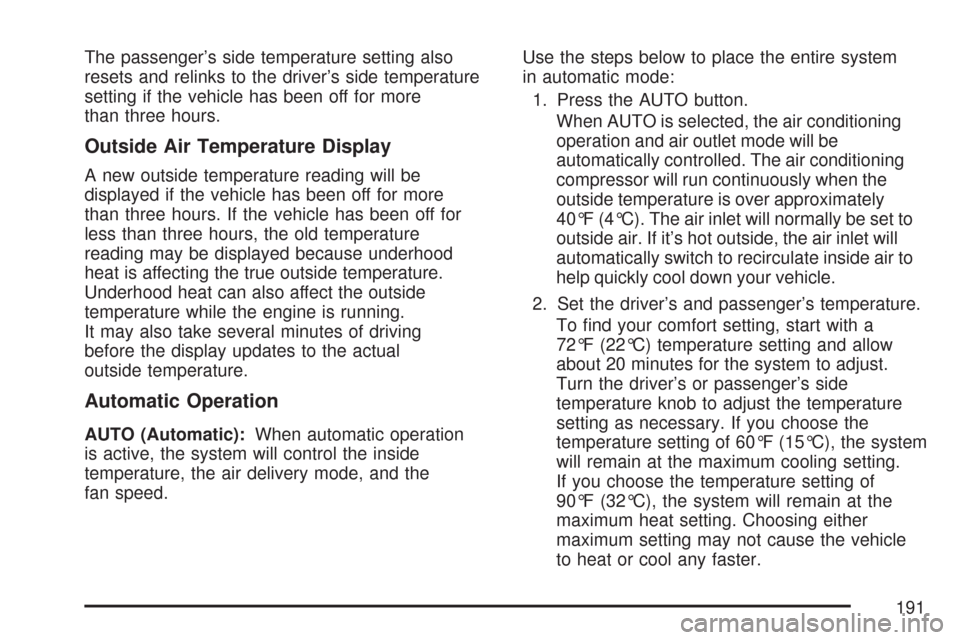
The passenger’s side temperature setting also
resets and relinks to the driver’s side temperature
setting if the vehicle has been off for more
than three hours.
Outside Air Temperature Display
A new outside temperature reading will be
displayed if the vehicle has been off for more
than three hours. If the vehicle has been off for
less than three hours, the old temperature
reading may be displayed because underhood
heat is affecting the true outside temperature.
Underhood heat can also affect the outside
temperature while the engine is running.
It may also take several minutes of driving
before the display updates to the actual
outside temperature.
Automatic Operation
AUTO (Automatic):When automatic operation
is active, the system will control the inside
temperature, the air delivery mode, and the
fan speed.Use the steps below to place the entire system
in automatic mode:
1. Press the AUTO button.
When AUTO is selected, the air conditioning
operation and air outlet mode will be
automatically controlled. The air conditioning
compressor will run continuously when the
outside temperature is over approximately
40°F (4°C). The air inlet will normally be set to
outside air. If it’s hot outside, the air inlet will
automatically switch to recirculate inside air to
help quickly cool down your vehicle.
2. Set the driver’s and passenger’s temperature.
To �nd your comfort setting, start with a
72°F (22°C) temperature setting and allow
about 20 minutes for the system to adjust.
Turn the driver’s or passenger’s side
temperature knob to adjust the temperature
setting as necessary. If you choose the
temperature setting of 60°F (15°C), the system
will remain at the maximum cooling setting.
If you choose the temperature setting of
90°F (32°C), the system will remain at the
maximum heat setting. Choosing either
maximum setting may not cause the vehicle
to heat or cool any faster.
191
Page 192 of 574
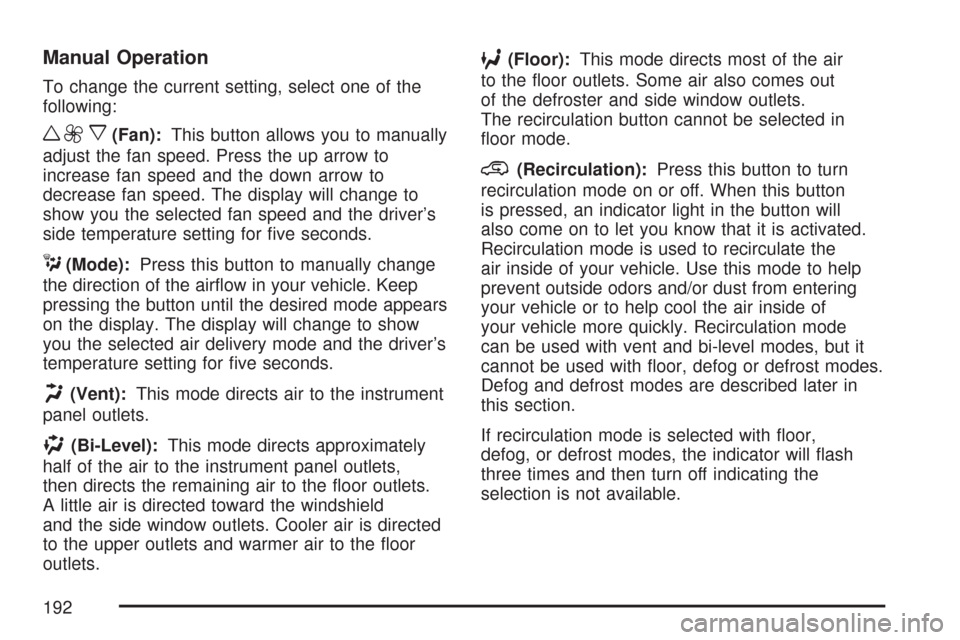
Manual Operation
To change the current setting, select one of the
following:
w9x(Fan):This button allows you to manually
adjust the fan speed. Press the up arrow to
increase fan speed and the down arrow to
decrease fan speed. The display will change to
show you the selected fan speed and the driver’s
side temperature setting for �ve seconds.
C(Mode):Press this button to manually change
the direction of the air�ow in your vehicle. Keep
pressing the button until the desired mode appears
on the display. The display will change to show
you the selected air delivery mode and the driver’s
temperature setting for �ve seconds.
H(Vent):This mode directs air to the instrument
panel outlets.
)(Bi-Level):This mode directs approximately
half of the air to the instrument panel outlets,
then directs the remaining air to the �oor outlets.
A little air is directed toward the windshield
and the side window outlets. Cooler air is directed
to the upper outlets and warmer air to the �oor
outlets.
6(Floor):This mode directs most of the air
to the �oor outlets. Some air also comes out
of the defroster and side window outlets.
The recirculation button cannot be selected in
�oor mode.
@(Recirculation):Press this button to turn
recirculation mode on or off. When this button
is pressed, an indicator light in the button will
also come on to let you know that it is activated.
Recirculation mode is used to recirculate the
air inside of your vehicle. Use this mode to help
prevent outside odors and/or dust from entering
your vehicle or to help cool the air inside of
your vehicle more quickly. Recirculation mode
can be used with vent and bi-level modes, but it
cannot be used with �oor, defog or defrost modes.
Defog and defrost modes are described later in
this section.
If recirculation mode is selected with �oor,
defog, or defrost modes, the indicator will �ash
three times and then turn off indicating the
selection is not available.
192
Page 193 of 574

You may also notice that the air conditioning
compressor will run while in recirculation mode.
This is normal and will help to prevent fogging.
If the weather is cold and damp, the system may
cause the windows to fog while using recirculation
mode. If the windows do start to fog, select
defog or defrost mode and increase fan speed.
Recirculation mode, if selected, will be cleared
when the engine is turned off.
#A/C (Air Conditioning):Press this button
to manually turn the air conditioning system on
or off. When the system is on, the system
will automatically begin to cool and dehumidify
the air inside of your vehicle. The air conditioning
symbol will appear on the display when the
air conditioning is on and will turn off when the
air conditioning is off.If you turn the air conditioning off while in front
defrost or defog mode, the air conditioning symbol
will turn off, however, the A/C compressor will
remain on to help de-humidify the air inside
the vehicle. If one of the other modes is selected
the compressor will then turn the A/C off until
it is selected again or the AUTO button is pressed.
To avoid fogging the inside glass on rainy and
humid days at a temperature above freezing,
press the air conditioning button to run the A/C
compressor. Also it is best to avoid the use of the
recirculation mode except when maximum air
conditioning performance is needed or for short
times to avoid exterior odors.
You may notice a slight change in engine
performance when the air-conditioning compressor
shuts off and turns on again. This is normal.
193
Page 200 of 574
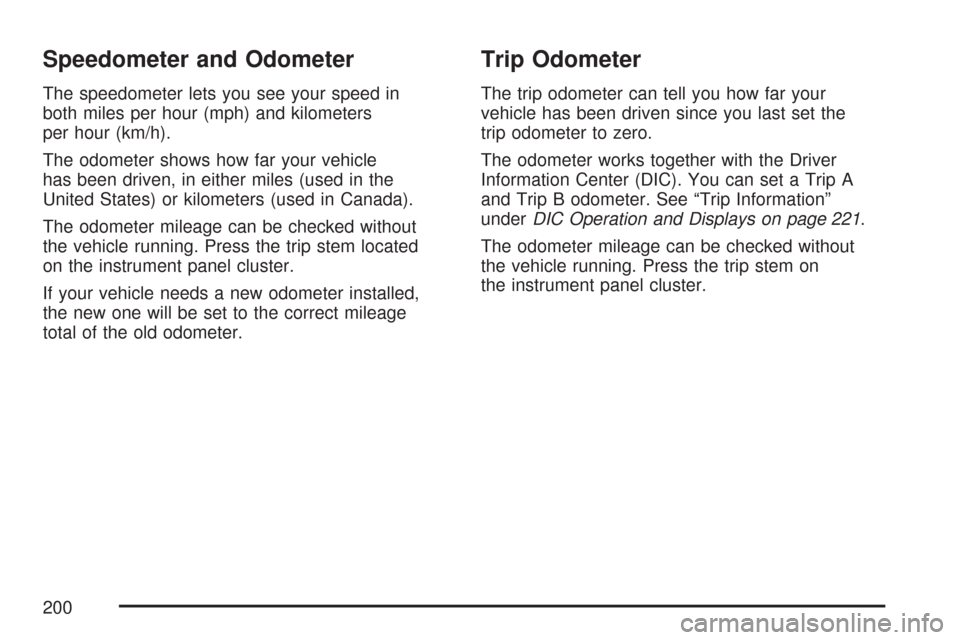
Speedometer and Odometer
The speedometer lets you see your speed in
both miles per hour (mph) and kilometers
per hour (km/h).
The odometer shows how far your vehicle
has been driven, in either miles (used in the
United States) or kilometers (used in Canada).
The odometer mileage can be checked without
the vehicle running. Press the trip stem located
on the instrument panel cluster.
If your vehicle needs a new odometer installed,
the new one will be set to the correct mileage
total of the old odometer.
Trip Odometer
The trip odometer can tell you how far your
vehicle has been driven since you last set the
trip odometer to zero.
The odometer works together with the Driver
Information Center (DIC). You can set a Trip A
and Trip B odometer. See “Trip Information”
underDIC Operation and Displays on page 221.
The odometer mileage can be checked without
the vehicle running. Press the trip stem on
the instrument panel cluster.
200
Page 201 of 574
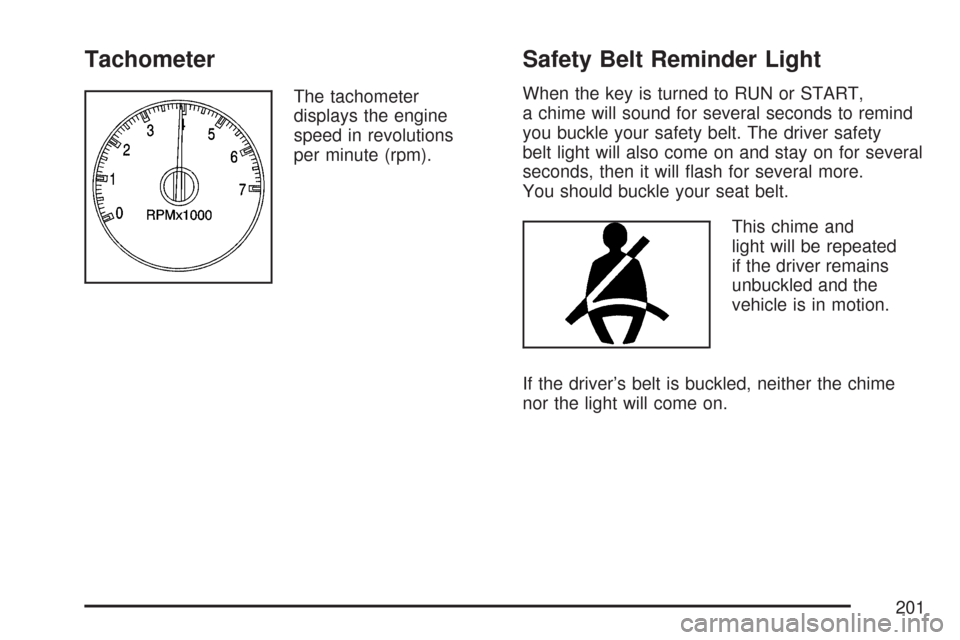
Tachometer
The tachometer
displays the engine
speed in revolutions
per minute (rpm).
Safety Belt Reminder Light
When the key is turned to RUN or START,
a chime will sound for several seconds to remind
you buckle your safety belt. The driver safety
belt light will also come on and stay on for several
seconds, then it will �ash for several more.
You should buckle your seat belt.
This chime and
light will be repeated
if the driver remains
unbuckled and the
vehicle is in motion.
If the driver’s belt is buckled, neither the chime
nor the light will come on.
201
Page 207 of 574
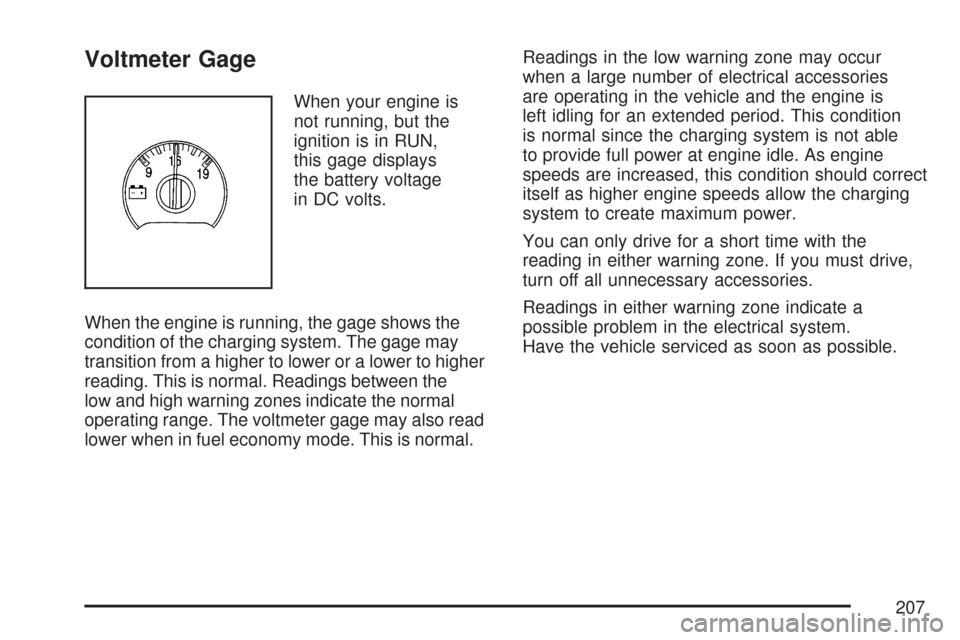
Voltmeter Gage
When your engine is
not running, but the
ignition is in RUN,
this gage displays
the battery voltage
in DC volts.
When the engine is running, the gage shows the
condition of the charging system. The gage may
transition from a higher to lower or a lower to higher
reading. This is normal. Readings between the
low and high warning zones indicate the normal
operating range. The voltmeter gage may also read
lower when in fuel economy mode. This is normal.Readings in the low warning zone may occur
when a large number of electrical accessories
are operating in the vehicle and the engine is
left idling for an extended period. This condition
is normal since the charging system is not able
to provide full power at engine idle. As engine
speeds are increased, this condition should correct
itself as higher engine speeds allow the charging
system to create maximum power.
You can only drive for a short time with the
reading in either warning zone. If you must drive,
turn off all unnecessary accessories.
Readings in either warning zone indicate a
possible problem in the electrical system.
Have the vehicle serviced as soon as possible.
207
Page 220 of 574
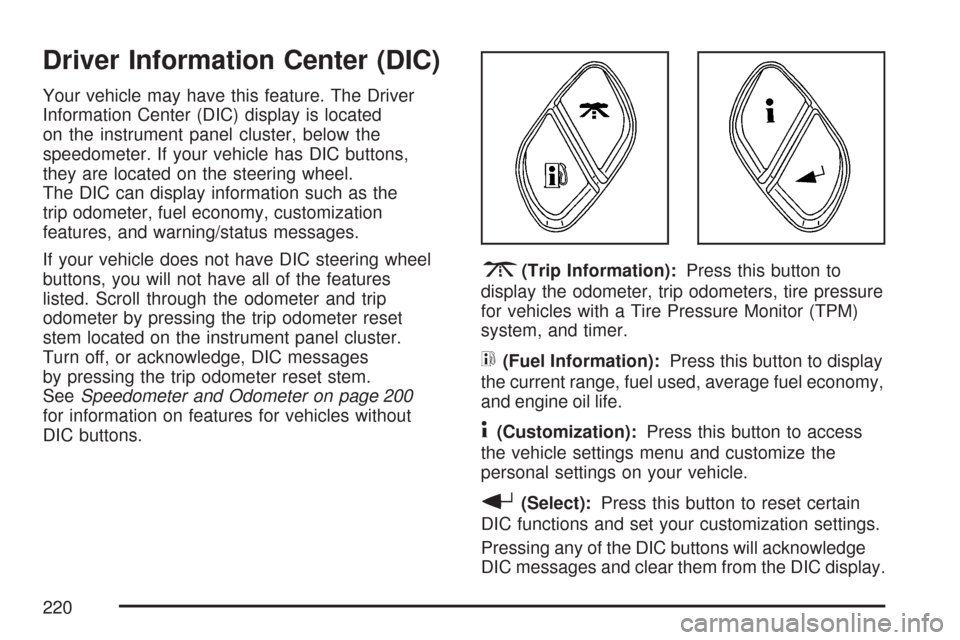
Driver Information Center (DIC)
Your vehicle may have this feature. The Driver
Information Center (DIC) display is located
on the instrument panel cluster, below the
speedometer. If your vehicle has DIC buttons,
they are located on the steering wheel.
The DIC can display information such as the
trip odometer, fuel economy, customization
features, and warning/status messages.
If your vehicle does not have DIC steering wheel
buttons, you will not have all of the features
listed. Scroll through the odometer and trip
odometer by pressing the trip odometer reset
stem located on the instrument panel cluster.
Turn off, or acknowledge, DIC messages
by pressing the trip odometer reset stem.
SeeSpeedometer and Odometer on page 200
for information on features for vehicles without
DIC buttons.
3(Trip Information):Press this button to
display the odometer, trip odometers, tire pressure
for vehicles with a Tire Pressure Monitor (TPM)
system, and timer.
t(Fuel Information):Press this button to display
the current range, fuel used, average fuel economy,
and engine oil life.
4(Customization):Press this button to access
the vehicle settings menu and customize the
personal settings on your vehicle.
r(Select):Press this button to reset certain
DIC functions and set your customization settings.
Pressing any of the DIC buttons will acknowledge
DIC messages and clear them from the DIC display.
220
Page 221 of 574
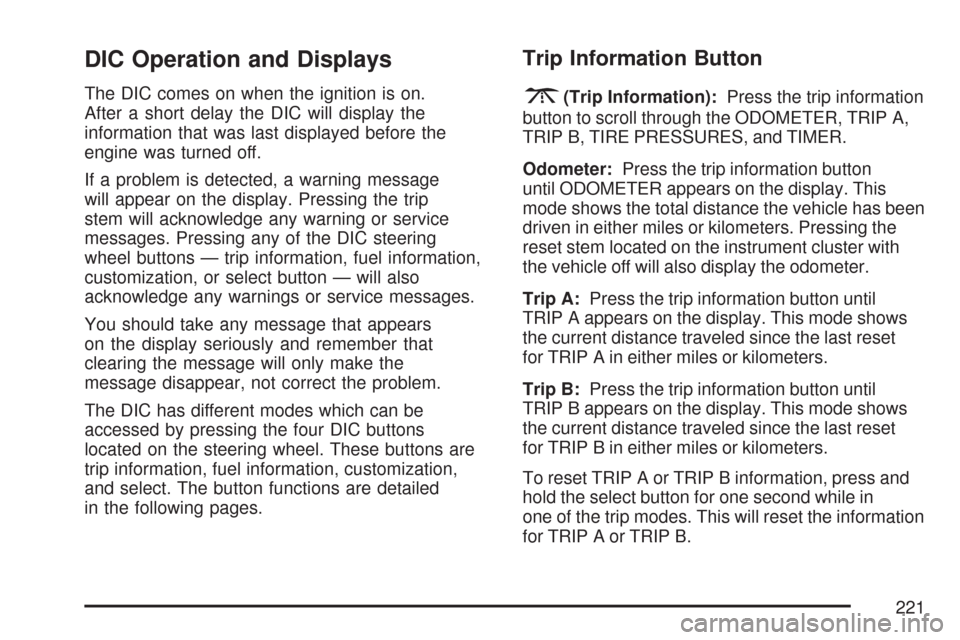
DIC Operation and Displays
The DIC comes on when the ignition is on.
After a short delay the DIC will display the
information that was last displayed before the
engine was turned off.
If a problem is detected, a warning message
will appear on the display. Pressing the trip
stem will acknowledge any warning or service
messages. Pressing any of the DIC steering
wheel buttons — trip information, fuel information,
customization, or select button — will also
acknowledge any warnings or service messages.
You should take any message that appears
on the display seriously and remember that
clearing the message will only make the
message disappear, not correct the problem.
The DIC has different modes which can be
accessed by pressing the four DIC buttons
located on the steering wheel. These buttons are
trip information, fuel information, customization,
and select. The button functions are detailed
in the following pages.
Trip Information Button
3
(Trip Information):Press the trip information
button to scroll through the ODOMETER, TRIP A,
TRIP B, TIRE PRESSURES, and TIMER.
Odometer:Press the trip information button
until ODOMETER appears on the display. This
mode shows the total distance the vehicle has been
driven in either miles or kilometers. Pressing the
reset stem located on the instrument cluster with
the vehicle off will also display the odometer.
Trip A:Press the trip information button until
TRIP A appears on the display. This mode shows
the current distance traveled since the last reset
for TRIP A in either miles or kilometers.
Trip B:Press the trip information button until
TRIP B appears on the display. This mode shows
the current distance traveled since the last reset
for TRIP B in either miles or kilometers.
To reset TRIP A or TRIP B information, press and
hold the select button for one second while in
one of the trip modes. This will reset the information
for TRIP A or TRIP B.
221